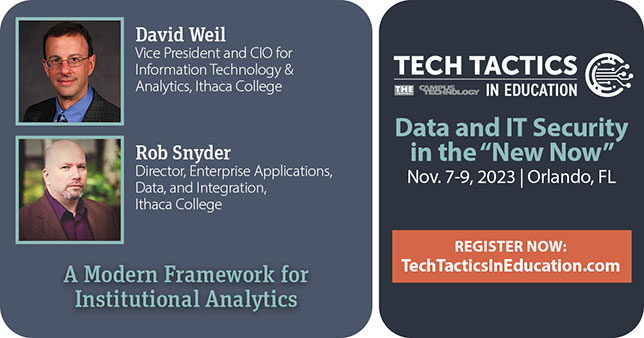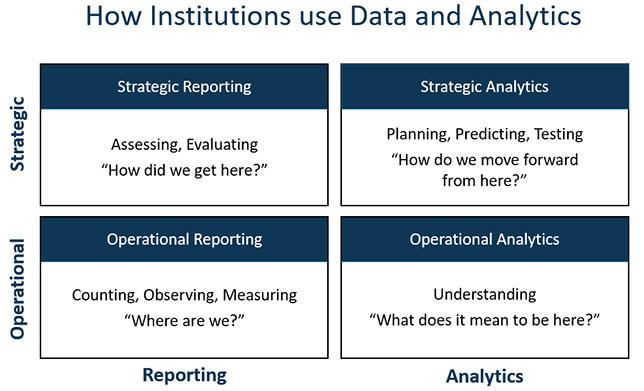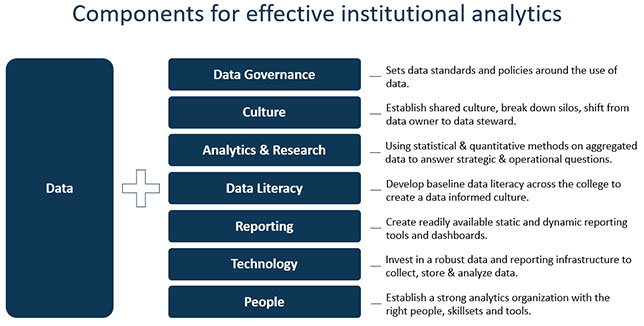Institutional Analytics: The Data Revolution in Higher Education
5 Questions with David Weil, Vice President and Chief Information and Analytics Officer, Information Technology & Analytics, at Ithaca College
Data is the key to all institutional analytics. Whether it's payroll data, employee information, or data on teaching and learning, the quality of the data, its accessibility, the way it's shared, and, of course, its governance: As has been said elsewhere, data is the new currency of higher education institutions.
According to David Weil, vice president, chief information and analytics officer at Ithaca College, universities and colleges are all at different points, or stages, of maturity in their analytics and how they use this tool to impact services across the institution.
"It all comes down to data," said Weil in an interview with Campus Technology, "And I have thought [that] for a number of years as an IT professional. Sure. You know, we're providing the technology, but we're really enabling the data to flow through our organization. And increasingly, that really is a primary role of the chief information officer. And so if we think about the data: How do we use the data? How does it help inform us about student success, about our enrollment, about our financial status? And then, how do we organize around being able to leverage that data?"
Weil recently sat down to talk with Campus Technology about the evolution of institutional analytics. He will be participating in two sessions at the upcoming Tech Tactics in Education conference, being held Nov. 7–9 in Orlando, FL: A Modern Framework for Institutional Analytics and The State of AI in Education.

Campus Technology: Can you talk about the maturity model that you use or that you recommend for evaluating institutional analytics? [Weil later provided the diagrams for illustration, below.]
We wanted a way to really think about the different use cases for institutional data and what a mature program looks like. So we created a four-quadrant maturity model, which is really divided up into two broad categories, … reporting analytics. And then you have two rows, operational, strategic.

Rob Snyder, our director of analytics and special IT projects (and co-presenter for the session at Tech Tactics), provided [these examples illustrating the model's concepts in the context of student retention]:
-
Operational Reporting — counting, observing, measuring — "Which students have enrolled for their third semester? Which students took a leave of absence? Who withdrew?"
-
Strategic Reporting — assessing, evaluating — "Which programs were these students in? What was their financial aid package? What was their first-year academic outcome?"
-
Operational Analytics — understanding — "How did this affect enrollment and financial sustainability, now and into the future? Are there any patterns in the students who weren't retained? What are the profiles of these students, and are those profiles different from the retained population?"
-
Strategic Analytics — planning, predicting, testing — "Can we identify students who are at risk? Are the policy changes we can make to influence retention, and how would that change the prediction? Should we make changes to financial aid, and what would be the ROI? Do we need to look at offering new services and mechanisms for support?"
What are the components that an institution needs to have in place in order to effectively do this? You refer to them as competencies?
You … have to have these eight competencies.
-
Data [itself] would be considered one of the competencies.
-
You have to have data governance, which helps decide how you describe data. What does full-time student mean? Who has access to that data?
-
Culture. You [need] data stewards. What is the culture around the use of data, the analytics? It's an institution data, not my data, so we're gonna share.
-
The use of data, the analytics, it's the ability to [ensure] data scientists and others to be able to actually do the advanced analysis on the data.
-
Data literacy is being able to interpret the data and understand what it's telling you.
-
Reporting is the ability to get the information out of the data….
-
Technology is a very broad category, but that's your data repositories … and the reporting tools.
-
And then, of course, you need the people to be able to do all that.
And so as you are maturing your use of data, you need to be really focusing on these eight competencies.

Where do you think a lot of the institutions that you collaborate with or work with are at as far as those competencies go?
I think we are all over the map.
What we're going to talk about [in our session at Tech Tactics] is really a framework through which they can be thinking about their programs and the elements that are needed for success. How people actually develop each of those eight competency areas. It's a way to think about it and frame the conversation with the leadership at those institutions.
So that's really what our goal is, again, to allow people to take a, a step back and say, okay, you know, what do we need to advance this at our institution?
Can you talk about what some of the limitations are of this particular approach? I know every maturity model has different limitations.
I think, getting people to agree on how they are using the data and analytics. And also, [the model] doesn't go into the why as much. About why you would want to do strategic analytics or why you want to be in any particular quadrant. And again, it's not like, oh, we're trying to get everyone here. It's like you, I believe you need to have functions in all four quadrants in order to be successful. If you were just doing strategic analytics about how do we move forward, you wouldn't be able to know how many students are coming in the door or those other things. You need to be able to do the operational reporting: What are my account balances? What's my cash flow? So you need to be in each of the four quadrants. I think that's important.
You're also participating in a panel on AI in education. How is AI coming into play in this this specific area?
AI is just growing so rapidly and evolving incredibly rapidly. I think the AI can help us organize our information in ways that we were not as able to do so as easily. AI can look for connections between things that we may have missed using some other technology. I think the generative AI that a lot of the companies are starting to build into their tool set will empower people across the institution to have more direct access to data and information to ask questions and make decisions themselves.
For example, in the past, if you wanted to build a dashboard, or you wanted information about something, you would have to work with our analytics group to build a dashboard using whatever tools we are using behind the scenes to build that. Microsoft, [for example], has announced some tools that are AI-based, that can ingest our data set, … apply some of the same powerful AI tools to that data so that I, as an end user, in Excel or PowerPoint or whatever Microsoft tool that I happen to be using, can run some of these more advanced queries against our data.
Now, again, this speaks to the importance of data governance, so that people know if it says FTE what that means … or what credit means or the [other] various terms there.
But I think that AI is really opening up a world of possibility for people to empower them to be able to do more.
What does it mean for the skill sets that I need to hire for going forward? I think that the whole evolution of AI is allowing us to operate almost at a higher level where the tools can do some of the foundational work that I had to hire programmers in the past or database administrators or others. Now, or at least in the near future, I won't necessarily have to hire a programmer with skills in a particular language. But I may need to hire someone who, you know, understands the architecture or the flow or the larger picture. And then they'll be able to use these tools to generate the specific code in a specific language set to do something. So I think it sort of changes the skill set. In some respects, I think it actually makes the case for higher education. Because we need bigger thinkers; we need strategic thinking; we need people that are able to operate in some respects, at a higher intellectual level, and AI can do some of the more foundational work going forward.
Then you have a whole area of AI and its impact on teaching and learning, which is another part of a conversation that I think is interesting, and very important, as higher ed institutions grapple with that.